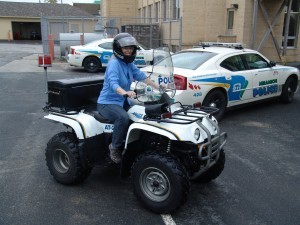Lea Wait's Blog, page 311
September 12, 2014
Addiction on Trial – An Interview with Dr. Steven Kassels
From time to time, Maine Crime Writers like to introduce you to other Maine writers and to new books for (we hope) ever growing TBR pile. Today our guest is Dr. Steven Kassels, whose book, Addiction on Trial, is garnering rave reviews for the way he uses a taut thriller to raise reader’s awareness of a major social problem. Here’s a description of the book:
 The Book: When Downeast local Annette Fiorno is found at the bottom of a ravine, outsider and relapsed drug addict Jimmy Sedgwick is accused of murder. Unassuming Maine lawyer Rob Hanston and big shot attorney Shawn Marks form an unlikely legal team as they attempt to discredit the overwhelming evidence. Addiction on Trial, the first in a series of Shawn Marks Thrillers, revolves around the murder cases of attorney Marks, an egotistical yet likable high-powered Boston attorney who can juggle an array of female companions without taking his eye off the legal challenges of his work. Addiction on Trial sends a powerful message of societal discrimination toward drug addicts and explores common misperceptions about what drug addiction really is—a chronic illness requiring a treatment approach similar to other chronic diseases. Medical and behavioral aspects of addiction are woven into the intrigue of this thriller, which culminates in a riveting murder trial.
The Book: When Downeast local Annette Fiorno is found at the bottom of a ravine, outsider and relapsed drug addict Jimmy Sedgwick is accused of murder. Unassuming Maine lawyer Rob Hanston and big shot attorney Shawn Marks form an unlikely legal team as they attempt to discredit the overwhelming evidence. Addiction on Trial, the first in a series of Shawn Marks Thrillers, revolves around the murder cases of attorney Marks, an egotistical yet likable high-powered Boston attorney who can juggle an array of female companions without taking his eye off the legal challenges of his work. Addiction on Trial sends a powerful message of societal discrimination toward drug addicts and explores common misperceptions about what drug addiction really is—a chronic illness requiring a treatment approach similar to other chronic diseases. Medical and behavioral aspects of addiction are woven into the intrigue of this thriller, which culminates in a riveting murder trial.
1. As a physician, how did the area of addiction become of interest to you and what are some of your concerns?
As a physician working in emergency medicine, I became aware that in many cases, more than 50% of patient visits to the hospital emergency room were related, either directly or indirectly to the disease of addiction. For example, the child with asthma due to a parent smoking in the home, the unexpected teenage pregnancy due to drugs or alcohol, auto accidents, patients feigning back pain or kidney stones to get pain medications, heart disease, etc. This led me to also become board certified in addiction medicine. As I continued in my years of practice in Emergency Medicine and Addiction Medicine, I have had the privilege to treat patients from all walks of life as there are no socioeconomic or geographical barriers to most illnesses or addictive behaviors.
From a medical perspective, it is very clear that we have differences, but we are more similar than not. When we are sick, we all benefit from compassion and care. Society should not differentiate between what diseases we should treat.
Accessible treatment (location and cost) needs to be available to patients with the disease of addiction. How is treating one with chronic drug addiction any different than treating one with chronic diabetes? Both can have a genetic predisposition and for both there can be a strong socialization element as well. Who wants to be the only person not drinking alcohol at a party or not eating a piece of birthday cake? If medications are readily available to treat diabetics, are they prescribed along with the necessary referral to meet with a nutritionist or dietician about dietary choices/changes? Should not this type of supportive counseling also be readily available for patients with addictive-related diseases?
2. What led you to write the book and how did you come up with the theme?
As a physician, I have learned an incredible amount from the many courageous patients who entrusted me with their medical care. Since I always wanted to write a novel, what better way to entertain than to combine my knowledge as a physician with my imagination as a fictional storyteller; albeit based on medical and legal truths? I also wanted to convey a message, but who wants to read another scientific book about addiction? Not me! So I created Addiction on Trial as a murder-mystery/legal thriller with the issues of addiction woven throughout the storyline.
I hope I have accomplished my two goals: one being to educate about addiction without it coming across as a lecture, to encourage discussions, and to raise awareness that the disease is everywhere; the other to create an easy to read, sit on the beach or by the fire murder-mystery that would be enjoyed by readers and passed on to a friend, family member or acquaintance.
3. Why did you chose a work of fiction to address the complex issues of addiction and its effects on family and society?
As a physician with years of practice in both Emergency Medicine and Addiction Medicine, it became evident that many patients, and sometimes a majority of patients, presented to the Emergency Department with injuries or illnesses related to the disease of addiction, often relationships that aren’t immediately recognized such as the diabetic who has a food addiction, the heart attack patient who smokes and/or drinks excessive alcohol, the automobile accidents, the unexpected teenage pregnancy from having sexual relations while intoxicated, the relative or friend injured by a heroin/opiate addicted person bent on getting their prescription drugs. The list goes on and on.
When I would give lectures to a wide range of groups, it became evident that I was preaching to the choir and I needed to take the message to regular people, not just those working in the fields of addiction treatment. With the Heroin/Oxycontin addiction epidemic destroying communities across our nation, the desire to reach a broader group synced up with my longstanding desire to write a page turner. I put the impulses together – why not create a murder mystery/legal thriller based on medical and legal truths about addiction and educate through the back door?
By turning fact into fiction, I have been able to reach a much wider audience of readers; those who would not choose to pick up a scientific book book about addiction. The characters, some from Maine and some from away, some with addiction and their families who live with them, are exposed through omniscient narration, allowing the reader to experience the despair and the hope that touches so many of us and our communities.
4. You set your novel in Maine. Why? What’s your connection to Maine?
Since one tends to write what one knows, and I have lived in Maine for the past seventeen years, now spending approximately five months on Mount Desert Island and the remaining time in Boston, I set my novel in Downeast Maine (and yes I know some prefer to spell it Down East Maine and my editors debated this one issue until the cows came home:) Unfortunately, Maine is not immune to opiate (heroin, oxycontin, etc) addiction; it has one of the highest rates and consequently now has more deaths that are drug related than from automobile accidents. Other reasons I chose the setting of Maine is because of my love for the state and wanting to make a change by using entertainment to also educate.
And of course, the setting of Downeast Maine would be a great backdrop for a blockbuster movie!
5. If we asked you to disclose a special Maine place that not everyone knows about, what would you tell us?
Mount Desert Island and Acadia National Park are no secrets. But there are some hidden gems that many do not know about. One such place is Little Hunters Beach, and although it can be accessed by the Park Loop Road of Acadia National Park, its secluded view from the road makes it a rarely visited spot. Take the steps and a ten minute stroll down to this cove with cliffs hanging above and listen to the smaller stones make their music as the surf carries them in and out and over and under. A wonderful place to get in touch with one’s soul!
5. Maine crime writers are also big foodies, so where in your part of Maine would you take us to eat, and why?
Let’s go on a journey to a place where time stopped in the 1950′s, but the culinary delights did not stand still. Isleford Dock Restaurant sits on Little Cranberry Island, just a 20 minute ferry ride from Southwest Harbor or Northeast Harbor on Mount Desert Island. Yes, that’s correct, we go island hopping to have lunch or dinner at this special spot sitting, as its name states, on the dock, surrounded by lobster boats galore.
On Tuesdays there is nary a seat to be had despite a limited menu because the main focus is the live music. But on other evenings the menu is a culinary delight with great variety for the vegetarian, pescetarian, or flexetarian (my daughter coined this phrase for those who usually don’t eat meat, but on rare occasions are “flexible” – hence “flexetarian). You will be amazed at the gourmet delights of Scallop Ceviche, Roasted Beets with whipped yogurt and spruce oil, the freshest of salads, or Lamb for Two Done 2 Ways. Other delights are Halibut with kohlrabi and fiddleheads, Lobster served with Burrata Cheese and pickled beach rose petals, great burgers and always a unique vegetarian entree. Sit at the bar or at a table and watch the sun set over the mountains of MDI. After dinner wander through the art gallery or the pottery store and take in life as it was decades ago!
Dr. Steven Kassels, physician and author, has been board certified in Addiction Medicine and  Emergency Medicine and has authored the book, Addiction on Trial: Tragedy in Downeast Maine. He is a graduate of Milton Academy, Lake Forest College, and Wayne State University School of Medicine. He has served as chief of Emergency Medicine at an inner city hospital and currently serves as the medical director and is a founding member of Community Substance Abuse Centers, with treatment facilities in Maine and throughout New England. Steve is a member of the American Society of Addiction Medicine and has presented numerous lectures and round table discussions on drug abuse related topics, as well as having testified as an expert witness at criminal trials. It is from these experiences that Steve has been able to create a crime fiction novel based on medical and legal truths. Steve has also written Op-eds for the Boston Globe and the Bangor Daily News and maintains an active blog, www.addictionontrial.com. Steve resides in Southwest Harbor, Maine and Boston, Massachusetts with his wife Ali. They have four children and five grandchildren. Steve’s other passions include tennis, backcountry skiing, biking, music and the Boston Red Sox.
Emergency Medicine and has authored the book, Addiction on Trial: Tragedy in Downeast Maine. He is a graduate of Milton Academy, Lake Forest College, and Wayne State University School of Medicine. He has served as chief of Emergency Medicine at an inner city hospital and currently serves as the medical director and is a founding member of Community Substance Abuse Centers, with treatment facilities in Maine and throughout New England. Steve is a member of the American Society of Addiction Medicine and has presented numerous lectures and round table discussions on drug abuse related topics, as well as having testified as an expert witness at criminal trials. It is from these experiences that Steve has been able to create a crime fiction novel based on medical and legal truths. Steve has also written Op-eds for the Boston Globe and the Bangor Daily News and maintains an active blog, www.addictionontrial.com. Steve resides in Southwest Harbor, Maine and Boston, Massachusetts with his wife Ali. They have four children and five grandchildren. Steve’s other passions include tennis, backcountry skiing, biking, music and the Boston Red Sox.
September 11, 2014
Begin…Again
Hi. Barb here.
Before starting this post, I looked back, and almost every one of us Maine Crime Writers has written a post about the beginning of the writing process. (And Lea Wait, I’d like to thank you for the ear worm of Michael Finnegan.)
It turns out, we are all over the board on how we begin writing our novels. Some of us have a period of pure research before we begin writing. Some actually wander through the physical landscape. Others write character bios and outlines.
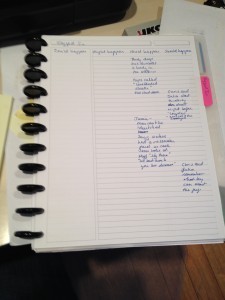 It seems I don’t even approach the task the same way every time. When I started Boiled Over, I mused about my pre-writing thoughts on that book. I had a lot of intentions. I’d thought a lot through. Not so much plot as theme, and what I wanted to achieve for myself and my series while writing the book.
It seems I don’t even approach the task the same way every time. When I started Boiled Over, I mused about my pre-writing thoughts on that book. I had a lot of intentions. I’d thought a lot through. Not so much plot as theme, and what I wanted to achieve for myself and my series while writing the book.
As I begin a new book this month, I’ve done a lot less conscious planning. True, I wrote a synopsis for my publisher back in July. I know the time of year (the weekend after Thanksgiving), the victim and the why of the murder.
But that’s pretty much it. It’s a locked room murder, something I’ve never written. A limited pool of suspects–four couples, eight individuals. I’m sure they’ll all be very interesting when I finally meet them, but honestly, I don’t know a thing about them. I’m just writing. And as each couple turns up on the scene, I’m making them up–on the spot.
I haven’t worked out the structure either, which is a little scary. As things are taking shape now, the body drop is in the first sentence of the first scene and the narrative moves between the forward action of the investigation and memories of the night of the murder. Seems a little tricky, requiring extra care with context and transitions. We’ll see if I can make this work, but so far, so good.
 The “story” is one my mother told me years ago. I’ve been carrying it around in my head ever since, certain I would write about it, but not sure how or when. A short story? A novel? Part of a series, or a standalone? Finally all the pieces have fallen into place and I’m ready to tell the tale. I think…
The “story” is one my mother told me years ago. I’ve been carrying it around in my head ever since, certain I would write about it, but not sure how or when. A short story? A novel? Part of a series, or a standalone? Finally all the pieces have fallen into place and I’m ready to tell the tale. I think…
I was on the Agatha Best Contemporary Novel panel with Julia Spencer-Fleming this spring and she said that Craig Johnson, author of the Longmire novels, told her, “You must worship at the Church of 1000 Words a Day.”
So that’s what I’m doing. A thousand words a day. I know plenty of people who write more, but I’m trying not to be competitive about it. First drafts are the worst part of the writing process as far as I’m concerned. Give me something to revise, no matter how rough, and I’ll work twelve hours a day. But setting an achievable goal for a first draft and kind of sneaking up on it seems to be working for me. So far.
We’ll see how this goes. It seems odd that I’m taking this loosey-goosey approach to a locked room mystery, arguably the most structured of the genre, but so far, so good. Or maybe the room wasn’t locked. (Though my protagonist just told the cops it was.)
Wish me luck and I’ll see you on the other side–I hope.
September 9, 2014
Shadows on a Maine Christmas
Lea Wait here, thrilled to announce the publication of the 7th in my Shadows Antique Print Mystery series. Shadows on a Maine Christmas is available now, in trade paperback or e-book in bookstores (ask your favorite bookstore to order it if it’s not in stock) and from on-line sellers.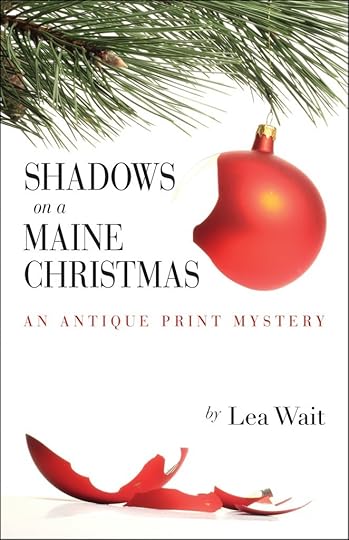
Publisher’s Weekly said it contained, “loving descriptions of the Maine winter and the area’s strong sense of community.” Mysterious Women: “Surprise ending .. beautifully written.” Kingdom Books: “one of the best and most intriguing plot twists … quick-paced and charming.”
So - I’m pleased. And relieved. Another child has been sent out into the world and, it seems, has had a good start.
So for today’s post, I thought I’d answer some of the questions I often get about my books.
How long does it take a book to be published? It varies. I signed a contract on the basis of a synopsis two years ago and handed in the manuscript of Shadows on a Maine Christmas one year ago.
Are you Maggie Summer? No! Yes, Maggie and I are both antique print dealers. We’ve both lived in New Jersey, and we both have graduate degrees in American Studies. But Maggie’s younger that I am (she’s now 39) and has darker hair and is much braver than I am. She gets involved in situations I’d shy away from. And, no, I don’t drink Diet Pepsi. (I drink tea.) Although Maggie and I both enjoy champagne and a good dry sherry.
Why set a mystery at Christmas? Because I love Christmas! The books in the Shadows series take place 3-5 months part, so, although it’s only been two months since Shadows on a Cape Cod Wedding, that book ended on a difficult note for Maggie’s relationship with her beau, Will Brewer. They needed to resolve some long-standing issues between them. Christmas seemed the right time for them to do that. (Although a little blackmail and murder do delay that a bit.)
Although the Shadows series is set today, you often include historical tidbits. Did you do that in Shadows on a Maine Christmas? I did. The mystery this time revolves around Will’s 91-year-old Aunt Nettie and several of her friends. They’ve kept each other’s secrets for years .. some since the second world war … so finding out what those secrets are, and why they’re important today, means going back in time a few decades. I love doing that!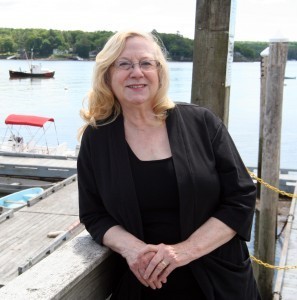
What gave you the basic idea for Shadows on a Maine Christmas? Alzheimers. It’s a horribly devastating disease, and one of its characteristic is that those who have it lose their short-term memory, but can remember events in the past. I wondered what would happen if someone started talking about those long-held secrets.
And will there by another Shadows book? Right now, it looks that way! I’m working on a synopsis, and am hoping to have a contract soon. If there is, it won’t be out until 2016. But in the meantime I’ll be working on books in my new series (Mainely Needlepoint) that begins in January, 2015, with Twisted Threads. That series will have a new book published every six months.
And thank you, to Maggie’s readers. If it weren’t for you …. I wouldn’t be plotting the 8th of her adventures!
It happens in a flash…
One minute, you’re riding your bike down Camden’s pretty Chestnut Street, admiring the row of pristine white homes. Your gaze lingers on your friend Rob’s house, and you think about how he is getting married in two weeks, and then….
You glance down and see your front tire in a giant hole, and in less time than it takes to shout out a good swear word, you’re flipping your bike. You have one thought as you somersault through the air: I could get seriously hurt.
Welcome to my new world. Last Thursday morning my front tire stopped dead in a hole and, because I was clipped in to the pedals, I soared over the handlebars (still attached to my bike) and landed on the pavement.

On my head and shoulder.
Seriously hurt? No. A broken collarbone and separated ligament, wrenched back and slightly bruised calf. Thanks to my helmet, no concussion. Thanks to my landing on said helmet, no road rash.
Nevertheless, it hurts and I’m curtailed from real physical activity for six weeks. My mind goes to all the things that could have happened, and at night I feel the sensation of landing on that pavement, although I’d like to forget it. So fast – in a flash – with nothing that I could have done to prevent it.
I do feel lucky. Of all the bones to break, the collarbone is one of the more forgiving. I can still write, walk, talk and eat. I didn’t wreck my bike and I’m recovering pretty well.
And now I have another experience to milk for fiction writing. Because things happen in a flash — they really do — and now I know what that feels like.
September 8, 2014
WHEN IN NEW SWEDEN, DON’T DRINK THE COFFEE!
Vaughn Hardacker here. There have been a number of crimes in Aroostook County, but few, if any received the national attention of the April 27, 2003 arsenic poisonings at the Gustaf Adolph Evangelical Lutheran Church.
On May 2, 2003, Daniel Bondeson was found in his New Sweden, Maine farmhouse where he had committed suicide. Bondeson’s death alone would have been news in this small community of 650 people, however it was else was found that really shocked the community. Nearby was a suicide note in which Bondeson confessed to putting liquid arsenic in the after service coffee at the Gustaf Adolph Evangelical Lutheran Church.
Until the discovery of the note, Bondeson was not even a suspect in the case. On April 27, 2003, there were complaints about the coffee served at the church coffee hour being bitter. No one had a clue that, bu the end of that day, sixteen people would become violently sick and one (Walter Reid Morrill, 78, known locally as Reid) would perish in short time medical personnel at the nearby Cary Medical Center in Caribou, Maine blamed arsenic poisoning.
Detectives assigned to the case by the Maine State police believed there was more than one parishioner to blame for the poisonings and were focusing on six to ten members of the fifty-person congregation. The police, including FBI profilers arrived and church members, including the victims’ relatives, were fingerprinted. They gave blood samples and filed out police questionnaires that went so far as to come right out ans ask them if they perpetrated the crime. The result of this was that people became suspicious of neighbors and relatives, many of whom they’d known for years. The began asking questions: Who skipped coffee hour? Who attended but did not drink coffee?
New Sweden and the surrounding communities (such as Stockholm, Westmanland, and Jemptland) is a shrinking remnant of the Swedish migration of the 1870s. Maine’s farmers were leaving the area to settle in the mid-west where the fields were flat and rich and the winters less harsh than that of Aroostook County. There was also a dispute between the state and French Canadian settlers from Canada as to where the northern border was. To secure its claim on the area, a contingent from Maine ventured to Scandinavia and recruited settlers with the lure of free land. The Swedish settlers immediately founded the Gustaf Adolph Evangelical Lutheran Church, named after a 17th century Swedish king.
In recent years, the closing of Loring Air Force Base hit the local economy hard and the potato market was being dominated by states in the Pacific Northwest. Aroostook County, with focus on the communities that surrounded the base (Caribou, Limestone, Fort Fairfield, and the Swedish Colony) were decimated and there was a migration of the area’s youth to places where they could more easily find employment.

Daniel Bondeson
Daniel Bondeson, a fifty-three year old bachelor, was a modest man who made a living farming, substitute teaching, and nursing. He was a dedicated runner who had competed in several Boston Marathons and an avid cross-country skier. He was well-known and like by many in the community. Even after the discovery of the suicide note many still find it difficult to believe that he would commit such a crime. In fact, many still don’t believe he’s guilty. One victim, Erich Margeson, was quoted by the Portland Press Herald as saying: “It does make you wonder whether I could have made a difference, to just go up and talk to him and be a better friend to him.” Some believe that he may have given the arsenic unwittingly to someone else and when he learned what it had been used for killed him self in remorse. (Arsenic is in no short supply around Aroostook county, especially in liquid form as, in years past, farmers used it to kill the tops and stems of their potato plants before harvesting the crop.) Some think that if he did do it, he may have done it because of the deaths of a brother, a nephew, and his father in recent years.
What stands in the face of all these theories was the damning part of the note in which Bondeson states: “I acted alone. I acted alone. One dumb poor judgement ruins life but I did wrong,” read the note, in which the first “I acted alone” was underlined. The note stated that he did not know that the chemical he put in the coffee pot before church members gathered socially after the Aug. 27, 2003, Sunday service was arsenic. “I thought it was something? I had no intent to hurt this way. Just to upset stomach, like the church goers did me.” It is thought that Bondeson had been upset with the church council over a new communion table that he and his brothers and sisters donated to the church in honor of their late mother and father.
Based on the information presented in the suicide note, on April 18, 2006, Maine Assistant Attorney General William R. Stokes, Chief of Criminal Division, and Colonel Craig Poulin, Chief of the Maine State Police, held a press conference in which they held that, as stated in his suicide note, Bondeson acted alone and “No further investigative efforts are planned in connection with this case.”
Many local residents to day feel that Danny Bondeson was not the perpetrator of this crime and that if not for the incriminating suicide note the case would have never been solved.
September 5, 2014
Weekend Update: September 6-7, 2014
 Next week at Maine Crime Writers there will be posts by Vaughn Hardacker (Monday), Vicki Doudera (Tuesday), Lea Wait (Wednesday), James Hayman (Thursday), and Barbara Ross (Friday).
Next week at Maine Crime Writers there will be posts by Vaughn Hardacker (Monday), Vicki Doudera (Tuesday), Lea Wait (Wednesday), James Hayman (Thursday), and Barbara Ross (Friday).
In the news department, here’s what’s happening with some of us who blog regularly at Maine Crime Writers:
Lea Wait: This week I’m celebrating the publication of the 7th book in my Shadows Antique Print mystery series. Available now in ebook and print forms, online and in bookstores, Shadows on a Maine Christmas takes Maggie Summer to Maine to celebrate the holiday with her beau, Will  Brewer, and his aged Aunt Nettie. It’s time: they need to make major decisions about the future of their relationship. But in the meantime, blackmail and murder get in the way of a totally Merry Christmas. Mysterious Women called it “beautifully written; Suspense Magazine said “Keeps the reader guessing until the very last page.” and Publisher’s Weekly commented, “loving descriptions of the Maine winter and the area’s strong sense of community.”
Brewer, and his aged Aunt Nettie. It’s time: they need to make major decisions about the future of their relationship. But in the meantime, blackmail and murder get in the way of a totally Merry Christmas. Mysterious Women called it “beautifully written; Suspense Magazine said “Keeps the reader guessing until the very last page.” and Publisher’s Weekly commented, “loving descriptions of the Maine winter and the area’s strong sense of community.”
On Wednesday evening, September 10, at 7 p.m. I’ll be speaking about Shadows on a Maine Christmas at the Wiscasset Library on High Street in Wiscasset, Maine. Saturday, September 13, I’ll be stopping at Twice Told Tales,/Moonstone Mystery Bookstore in Flemington, New Jersey to sign books there. Anyone near Flemington who’d like me to sign a book for them, call Marilyn Thiele at 908-788-9094 and she’ll reserve one for you. And later on September 13 my husband, Bob Thomas, and I will be at the Blank Canvas Gallery, 19 West Bridge Street in New Hope, PA, for the opening of an exhibit of his paintings, from 5 until 8 p.m. Would love to see readers and art lovers there!
Kate Flora: Belatedly chiming in here from the Writers’ Police Academy down in Greensboro, North Carolina, to share this link to a book trailer for my next Joe Burgess mystery, And Grant You Peace, created by the Amazing Tiffany Schofield at Five Star: http://youtu.be/BpKpQvJMoCY
I’d love to hear what you think. The book will be out in October.
An invitation to readers of this blog: Do you have news relating to Maine, Crime, or Writing? We’d love to hear from you. Just comment below to share. Don’t forget that comments are entered for a chance to win our wonderful basket of books and the very special moose and lobster cookie cutters.
And a reminder: If your library, school, or organization is looking for a speaker, we are often available to talk about the writing process, research, where we get our ideas, and other mysteries of the business. Contact Kate Flora: mailto: kateflora@gmail.com
September 4, 2014
Rethinking Plots
Kaitlyn Dunnett/Kathy Lynn Emerson here, thinking about plotting, and how it is a rare writer who can plan the entire novel in advance and stick to that plan from start to finish. If you are one of those lucky few, more power to you. Me? I’m stuck with a lot of rewriting and revising. On the bright side, every time I read through and make changes to a manuscript, it gets better.
Whatever doesn’t work in the rough draft of a novel, I can fix in revision. I can change the order of scenes. I can even change the point of view they are written in. I can add subplots and/or characters or delete them. I can heighten suspense. I can even change my mind about the identity of the villain. I’ve done this once or twice already.
 I wrote an entire draft of my second Diana Spaulding 1888 mystery, Fatal as a Fallen Woman, thinking one person was the killer, reached what was supposed to be the climax of the story, and realized that although that person was guilty of several other things that happened in the novel, the murder was not one of them. It was just not believable that my first choice for a villain would have killed this particular victim. Fortunately, when I went back to the beginning and reread the first three chapters, I realized that I’d already given an excellent motive to another character—a person Diana never even thinks to suspect in the first draft.
I wrote an entire draft of my second Diana Spaulding 1888 mystery, Fatal as a Fallen Woman, thinking one person was the killer, reached what was supposed to be the climax of the story, and realized that although that person was guilty of several other things that happened in the novel, the murder was not one of them. It was just not believable that my first choice for a villain would have killed this particular victim. Fortunately, when I went back to the beginning and reread the first three chapters, I realized that I’d already given an excellent motive to another character—a person Diana never even thinks to suspect in the first draft.
Neither did I, but I guess my subconscious must have been working on the problem all along. Anyway, with this new villain in mind, it was remarkably easy to find places to plant clues. With the addition of one more chapter after what I’d originally planned would be the end of the book, I ended up with a much better (and more believable) novel.
Since I am incapable of making a detailed synopsis before I start to write (I do keep a chapter outline, much revised, as I go along) my rough drafts are always ragged and full of notes to myself like “add humor here” and “Liss discovers a clue.” Usually, I have no idea what that clue is. Despite that shortcoming, somehow, inspiration eventually strikes.
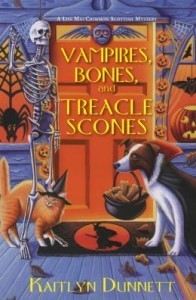 Vampires, Bones, and Treacle Scones, just out this week in mass market paperback (it came out last fall in hardcover and ebook formats) is a mystery novel that was definitely improved by some rethinking when it came to the plot and, in this case, one particular character. When I started writing, I threw in a random teenaged boy. He was intended partly as comic relief and partly as a complication for Liss, who was trying to involve Moosetookalook’s young people in planning the village’s Halloween festival. I made him a member of the Snipes family, first seen in The Corpse Wore Tartan, a clan of ne’er-do-wells with no redeeming characteristics whatsoever.
Vampires, Bones, and Treacle Scones, just out this week in mass market paperback (it came out last fall in hardcover and ebook formats) is a mystery novel that was definitely improved by some rethinking when it came to the plot and, in this case, one particular character. When I started writing, I threw in a random teenaged boy. He was intended partly as comic relief and partly as a complication for Liss, who was trying to involve Moosetookalook’s young people in planning the village’s Halloween festival. I made him a member of the Snipes family, first seen in The Corpse Wore Tartan, a clan of ne’er-do-wells with no redeeming characteristics whatsoever.
This kid, “Boxer” Snipes by name, had his own ideas about that. He came in cracking wise and irritating everyone in sight but there was just something about him . . . . It took me awhile to figure out what it was. At first I thought it was just his resemblance to a boy in one of my classes during a brief, unsuccessful stint as a teacher of seventh grade language arts. That did play into developing Boxer’s character—the kid who seems doomed to failure because everyone, past teachers included, assumes he’s as useless as the rest of his family. I always hoped this “bad” kid could be saved. In real life, he wasn’t. In fiction, he had a chance of success.
 That alone would have worked as a subplot, but once again Boxer had his own ideas. To begin with, I had no idea who he really was, or how important he was going to be to the climax of the novel. Picture the proverbial light bulb going on over my head. Once I realized that Boxer was destined to play a bigger role in the story, I also knew who would be falsely accused of murder and why Liss would get involved in finding the real killer, even after swearing she was done with amateur sleuthing. I can’t say any more without spoilers, but the upshot was that, once again, rethinking led to a better, more complex novel.
That alone would have worked as a subplot, but once again Boxer had his own ideas. To begin with, I had no idea who he really was, or how important he was going to be to the climax of the novel. Picture the proverbial light bulb going on over my head. Once I realized that Boxer was destined to play a bigger role in the story, I also knew who would be falsely accused of murder and why Liss would get involved in finding the real killer, even after swearing she was done with amateur sleuthing. I can’t say any more without spoilers, but the upshot was that, once again, rethinking led to a better, more complex novel.
 For Murder in the Queen’s Wardrobe, I’d had the general plot in mind for a couple of years, since it is based on a real event, the request by Ivan the Terrible of Russia (then called Muscovy) for an English “princess” as his bride. Queen Elizabeth’s cousin, Lady Mary Hastings, was singled out for this dubious honor. Originally, this storyline was proposed for the series of non-mystery historical novels I wrote as Kate Emerson, but the editor wanted to stick with the court of Henry VIII. I still liked the premise, so it went into my “ideas” file and re-emerged last year to become the first in a new mystery series featuring Mistress Rosamond Jaffrey, a young Elizabethan gentlewoman, as the series detective.
For Murder in the Queen’s Wardrobe, I’d had the general plot in mind for a couple of years, since it is based on a real event, the request by Ivan the Terrible of Russia (then called Muscovy) for an English “princess” as his bride. Queen Elizabeth’s cousin, Lady Mary Hastings, was singled out for this dubious honor. Originally, this storyline was proposed for the series of non-mystery historical novels I wrote as Kate Emerson, but the editor wanted to stick with the court of Henry VIII. I still liked the premise, so it went into my “ideas” file and re-emerged last year to become the first in a new mystery series featuring Mistress Rosamond Jaffrey, a young Elizabethan gentlewoman, as the series detective.
There were still quite a few things I didn’t know when I started writing. I didn’t know who the murderer was or why that person would try to disrupt a marriage treaty between England and Muscovy. I didn’t have any idea, either, how I was going to wrap up the subplot, which involves my spy/sleuth, Rosamond (in England), and her estranged husband, Rob Jaffrey (in Muscovy). Get Rosamond to Russia? Bring Rob home? Kill Rob off? My biggest advantage was that I didn’t have a deadline. I wrote this novel “on spec”—without a contract. That also meant I didn’t have to come with a synopsis in advance, a major plus from my point of view.
Eventually, it all began came together. After some major rethinking and revision the pieces fell into place. Did I figure out the best way to deal with everything? That’s something readers will have to tell me when the book comes out in March of 2015.
September 3, 2014
And Finally – Some Good News!
The marvelous writer Kate Atkinson has a book in her Brodie series titled, When Will There Be Good News? I know how Jackson Brodie feels in that story, because sometimes, even though I am accustomed to the part of the writer’s life that means I may live with a book, and a cast of characters, for years, I never get used to the process on the selling and publishing side. On the fiction side, there’s the book itself, plus the synopsis, query letter and the sample chapters. In the nonfiction world, it is all of the above plus a lengthy book proposal including the potential audience and similar books, and a marketing plan. Then there’s the timing of it all–It’s a process of write and rewrite for years, then give everything to the agent, and wait.
From time to time, the agent will forward rejection letters. These can be ‘crawl under the desk, fold my paws over my head, and whimper’ moments. When I started writing, rejections came by mail, so there was a breather between send it out and get rejected; these days, they come faster, because submissions are electronic, and so are rejections.
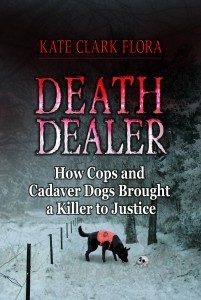 Here’s how Death Dealer came about. Back in 2006, we had a launch party for Finding Amy: A True Story of Murder in Maine. Lt. Pat Dorian of the Maine warden service, who had been instrumental in organizing the massive search effort that ultimately found Amy’s buried body, was at the party. Half way through the evening, he grinned at me and said, “When you’re ready, Kate, I have another one for you.” At the time, I’d sworn I would never write nonfiction again. Writing mystery or suspense fiction takes me about a year. Writing that nonfiction book took two and a half years. Along the way, I discovered it was too hard to write about real crime victims. I was never going to do anything like that again. But about two years later, having gotten some distance and remembering how fascinating it was to work on a real story, I called him up and asked him about that next one.
Here’s how Death Dealer came about. Back in 2006, we had a launch party for Finding Amy: A True Story of Murder in Maine. Lt. Pat Dorian of the Maine warden service, who had been instrumental in organizing the massive search effort that ultimately found Amy’s buried body, was at the party. Half way through the evening, he grinned at me and said, “When you’re ready, Kate, I have another one for you.” At the time, I’d sworn I would never write nonfiction again. Writing mystery or suspense fiction takes me about a year. Writing that nonfiction book took two and a half years. Along the way, I discovered it was too hard to write about real crime victims. I was never going to do anything like that again. But about two years later, having gotten some distance and remembering how fascinating it was to work on a real story, I called him up and asked him about that next one.
His response led me hundreds of miles north, to the small New Brunswick city of Miramichi, and to

The sentinel tree used to locate the hidden body
another police department and another missing body. Along the way, there would be endless appeals, a second full murder trial and a second guilty verdict. There would be trips north and the discovery of a marveous bed & breakfast, where one weekend, the proprietors left me in charge of the inn and went away. There would be the development of a deep affection for the people who spoke with me so openly. A deepened understanding of how terrifying it can be for ordinary people to come into court and testify against someone they know has killed a loved one.
In the midst of this journey, there was the New York agent who told me not to waste time on the book, because no publisher would ever buy a book by an American author about a Canadian crime, especially not a small town, not big headlines Canadian crime. And anyway, no one was interested in Canadian crime. But by then, I was attached to my characters, and to the story. I couldn’t walk away.
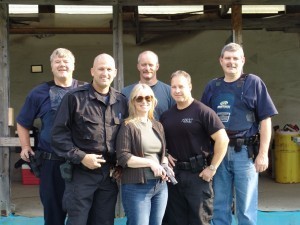
Sometimes research takes me in some strange directions, like to the shooting range.
Fast forward. Writing the book was a journey of more than five years. Death Dealer http://amzn.to/Z7uBQf is a compelling story, and it is finally finished. Not being a marketing person, I found someone on Elance to tart up the book proposal and make it a real marketing document. I found a determined and talented new agent. And waited with the weight of many people’s expectations resting on my shoulders.
It has been a very long journey. But I am smiling, and feeling a huge sense of relief, because in a week, Death Dealer be in print. I will not be letting down the many who put their faith in me, both in Canada and in Maine. Instead, I will be embarking on another part of the writer’s journey–the part where it becomes my job to convince readers they want to buy this book. To convince reviewers and bloggers to review it. And to wait, with baited breath, for the reviews that matter most–those of the real people whose story this is.
And here’s an excerpt from the first review:
Edgar-nominated author Kate Clark Flora tells the story of the investigation into Maria Tanisichuk’s disappearance from the unique perspective of those who investigated it. It offers a deeply compassionate insight into the challenges faced by the dedicated officers as they raced against time to find Maria’s body. Their adversaries were the sheer scale of the area to be searched and the warming weather which would melt the deep winter snow and result in decomposition, animal interference and a devastating loss of vital evidence.
The meticulously researched book is beautifully written with many touching and insightful observations about the plight of both investigators and the family of the victim. One really gets a sense that the author cares deeply about the victim and others affected by the tragedy and this is a quality which I particularly like in a writer.
For budding crime writers like myself, the book also offers a wealth of fascinating and useful information about the work of cadaver dogs.
It is pacy and incredibly atmospheric (something which is often lacking in true crime books) and for this reason, I highly recommend this book to readers of both true and fictional crime. http://thecrimewarp.blogspot.co.uk/2014/08/death-dealer-by-kate-clark-flora.html
September 2, 2014
Eye Candy
Hello again from Sarah Graves, writing to you once more from Eastport, Maine, where we are in one of the more lovely-to-look at times of year. The gardens are full of flowers and vegetables, the streets are full of people, the shop windows loaded with toys and treats, and even the fish are practically hopping onto hooks, the water is so jammed with them right now.
Speaking of which, there have been a few recipes here lately, so I thought I’d post one for baked mackerel: 1. Catch and clean mackerel. 2. Heat oven to 400. 3. Put mackerel into brown paper bag. Seal bag tightly and place on a baking sheet. 4. Bake for 30 minutes. 5. Remove mackerel. 6. Eat brown paper bag. Apologies to those who enjoy eating mackerel. I think it tastes like used crank case oil, but of course your mileage may vary on that.
Put mackerel into brown paper bag. Seal bag tightly and place on a baking sheet. 4. Bake for 30 minutes. 5. Remove mackerel. 6. Eat brown paper bag. Apologies to those who enjoy eating mackerel. I think it tastes like used crank case oil, but of course your mileage may vary on that. 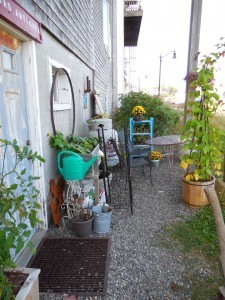
Here is a little garden just off the breakwater downtown. It just goes to show that you don’t need an acre of land to grow edibles while looking pretty darned snazzy at the same time. This is just a few feet from the water’s edge, too, so you can’t beat the view. Also, although it’s in the shade for half the day, it gets all that reflected light, so the vegetables are doing beautifully — even corn, which is in a half-barrel. If you’d like to grow corn but only have, say, a small terrace, it could work for you, too.
On the other hand, if you do have an acre (and a picturesque  shed, and a water view) you could try something like this. In my opinion there’s nothing like tiger lilies against weathered shingles. I keep saying I’m going to find some and put them into my own garden, but the truth is that I don’t have the right spot for them. What they’re standing against is as important as the lilies themselves, for me. If they’re just sticking up out of the ground with nothing around them, they look gawky. Or something.
shed, and a water view) you could try something like this. In my opinion there’s nothing like tiger lilies against weathered shingles. I keep saying I’m going to find some and put them into my own garden, but the truth is that I don’t have the right spot for them. What they’re standing against is as important as the lilies themselves, for me. If they’re just sticking up out of the ground with nothing around them, they look gawky. Or something.
 Haven’t had my annual lobster roll, yet. Context is important for the enjoyment of those, too. Luckily we have Quoddy Bay Lobster Company, complete with waterside picnic tables, a walk-up window to order at, a little indoor eating area in case it rains, and a refrigerated glass case displaying all the fresh fish you’ll want to take home with you after you eat lunch. They offer two sizes of lobster roll, huge and humungous. I personally am only able to surround the huge one. If you want to be really authentic about it you’ll wash it down with Moxie, of course.
Haven’t had my annual lobster roll, yet. Context is important for the enjoyment of those, too. Luckily we have Quoddy Bay Lobster Company, complete with waterside picnic tables, a walk-up window to order at, a little indoor eating area in case it rains, and a refrigerated glass case displaying all the fresh fish you’ll want to take home with you after you eat lunch. They offer two sizes of lobster roll, huge and humungous. I personally am only able to surround the huge one. If you want to be really authentic about it you’ll wash it down with Moxie, of course.
What’s a summer tourist destination without t-shirts, right? This is a window at the Quoddy Crafts![10653809_10204320457882050_2751757369489689923_n[1]](https://i.gr-assets.com/images/S/compressed.photo.goodreads.com/hostedimages/1409793808i/11023443.jpg) store, which in the past few years has exploded with improvements, activity, and creativity. “If you build it, they will come,” has proven true, here – from a sleepy little shop to a center for all kinds of handmade articles from quilts to clothing, pottery & paintings, jewelry, knitting – even scrub suits, so you can go to work wearing ones that no one else will have.
store, which in the past few years has exploded with improvements, activity, and creativity. “If you build it, they will come,” has proven true, here – from a sleepy little shop to a center for all kinds of handmade articles from quilts to clothing, pottery & paintings, jewelry, knitting – even scrub suits, so you can go to work wearing ones that no one else will have.
 Next weekend is the Pirate Festival, which marks the end of the festival season in Eastport. It’s already quieting down, but after Pirate Weekend there’s going to come a day when suddenly there’s something new in town, something we haven’t experienced for a long time: silence. Oh, we’ll still get leaf-peepers and others who aren’t tied to the school-year schedule, but it’s a long drive to get here and when the weather’s chilly, the beauty of the place gets to be…well, let’s say it’s an acquired taste.
Next weekend is the Pirate Festival, which marks the end of the festival season in Eastport. It’s already quieting down, but after Pirate Weekend there’s going to come a day when suddenly there’s something new in town, something we haven’t experienced for a long time: silence. Oh, we’ll still get leaf-peepers and others who aren’t tied to the school-year schedule, but it’s a long drive to get here and when the weather’s chilly, the beauty of the place gets to be…well, let’s say it’s an acquired taste.
A Somerset County Gem
A Somerset County Gem

The L.C. Bates Museum. Photo from their website.
Libraries are always looking for inexpensive, but information rich programs to enhance their summer offerings. At the Hartland Public Library, we’ve had the outreach staff at the L.C. Bates Museum, located on the Goodwill Hinkley Campus, do two programs each summer for the past three years. They are a screaming bargain and kids love the interactive and hands-on aspects. If you remember the post I did about our joint outdoor event at Hathorn Park, you saw pictures of the rocks and minerals table the Bates Museum had there.

That’s the LAST time I read one of James Hayman’s books during a thunder shower!
Beth and I have been meaning to go over to Hinkley and visit the museum all summer. On Sunday, we combined it with a stop at the Fairfield Antiques Mall (another really interesting place here in Somerset County). The Goodwill campus, comprising 2400 acres overlooking the Kennebec River a couple miles south of the big paper plant, has undergone a renaissance in the past couple years. There was a time when it looked pretty sad and abandoned, but thanks in part to the Alfond Foundation, there’s a new charter school dedicated to agricultural technology and a new second campus for Kennebec Valley Community College.

Mineral and fossil lovers are going to have a blast here.
The museum itself occupies three floors in an old brick building easily accessed from Rt. 201. Admission is $3.00 for adults, $1.00 for kids. The staff are friendly, eager to answer questions and extremely knowledgeable about the exhibits. (More about these in a bit). In addition to the outreach programs like the ones we have had them present at the library, they offer in-house programs for schools, again at extremely reasonable rates. Classes can choose from Maine Habitat Programs, Pond Explorations, Insects Everywhere, Maine Native Americans, Rocks, Minerals and Fossils, Maine’s Beautiful Birds, Maine Mammals and a new one this summer– Explore Maine Habitats Outdoors.
The museum also offers programs to the public. In September, you can take advantage of weekly sun viewings courtesy of their small outdoor observatory which will be available on sunny days between 1-3 pm (Wed-Fri). Bring a camera and try your hand at taking a photo of the sun. Saturday, September 6th at 1 pm, join the staff for Passenger Pigeon Day, to honor the 100th anniversary of their extinction and learn how it happened. That same day, you can join them at 7 pm for International Moon Night. Sunday, September 13th at 1, you can join them for How to Use a Printing Press and try your hand at setting type on an 1850′s Acorn Printing Press as well as learning about the newest printing phenomena, 3-D printing. On September 20th at 1, you can join the staff for a Fall Celebration walk to discover leaf changes that have just started, animal habits this time of year and the incredible story of migration.
Saturday mornings at ten are reserved for kids programs. Upcoming ones include Make Your Own Print on September 6th, Shell Pictures on the 13th, Why Do Leaves Change on the 20th, Migration on the 27th and Insects of the Forest on October 4th.
When you visit the museum, start by watching the video that tells the history of how Goodwill Hinkley began. Rev. Hinkley, a Baptist minister, had been profoundly affected by what happened to a childhood friend. He never forgot watching as the boy was sentenced to prison for stealing a half-eaten sandwich when he was starving. With the help of many compassionate people, he was able to create a place where troubled and parentless kids could have a safe place to live and a chance to become happy, productive people.
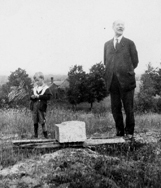
Reverend Hinkley, founder of Goodwill Hinkley. Photo courtesy od their website.
Take time to look over the amazing array of exhibits. The museum really does offer something for everyone. Kids (and adults) who love rocks and minerals will be thrilled by the room full of specimens from all over the world that occupies half of the basement. Bird lovers will be equally thrilled by the exhibit on the main floor (just a portion of some 600 specimens donated to the museum) and don’t hesitate to try the electronic bird call device. Downstairs you can see pretty much every animal in the Maine woods, as well as a few you aren’t likely to, unless global warming really speeds up. (No two toed sloths here yet, I hope). Most of them are in realistic dioramas. Keep an eye out for the really neat Fairy Bottles scattered throughout the exhibits. Fairy-loving kids (and adults) will get a kick out of the stories about the inhabitants).
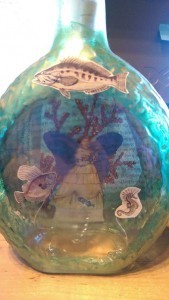
Who needs Cable. I’ve got an awesome place to explore right here.
Other exhibits include insects, art, fish, fossils, pottery and sculpture., in short, something for everyone. Cameras are not permitted, but the gift shop has postcards, souvenirs and tons of rock samples for every mineral lover. The museum is open as follows: April to mid-November, Wednesday to Saturday 10 AM to 4:30 PM and Sunday 1 to 4:30 PM and other times by appointment. Winter hours are Wednesday through Saturday 10AM to 4:30PM and other times by appointment or chance, please call 238-4250 to be sure we are here to greet you in winter. Closed if the roads are snowy. Please note that we are not heated in winter! Dress warmly if you come for a visit.
You can get a lot more information and see what is happening by friending them on Facebook (www.facebook.com/lcbates) or by checking out their website at http://www.gwh.org/lcbates/LCBatesMuseum.aspx There are also several easy hiking trails of less than a mile and maps are available at the museum. Bring a lunch and make a day of it. If you want to see more about the museum in pictures, check them out on the fantastic Maine Memory Network at www.MaineMemory.net

Bernard Langlais, 1976. Photograph by David Hiser, courtesy of the Colby College Museum of Art.
If you want to take advantage of another unique artistic opportunity in Maine, consider following the recently created Langlais Art Trail. You can learn about this amazing new cultural phenomenon here at www.langlaisarttrail.org
Lea Wait's Blog
- Lea Wait's profile
- 509 followers



